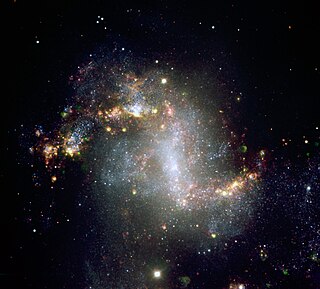
NGC 1313 is a field galaxy and a irregular galaxy discovered by the Scottish astronomer James Dunlop on 27 September 1826. It has a diameter of about 50,000 light-years, or about half the size of the Milky Way.

NGC 7070A is a face-on lenticular galaxy located about 100 million light-years away in the constellation of Grus.

NGC 6045 is a barred spiral galaxy located about 450 million light-years away in the constellation Hercules. NGC 6045 was discovered by astronomer Lewis Swift on June 27, 1886 and is a member of the Hercules Cluster. It is also a LINER galaxy.

NGC 4660 is an elliptical galaxy located about 63 million light-years away in the constellation Virgo. The galaxy was discovered by astronomer William Herschel on March 15, 1784 and is a member of the Virgo Cluster.

NGC 3311 is a super-giant elliptical galaxy located about 190 million light-years away in the constellation Hydra. The galaxy was discovered by astronomer John Herschel on March 30, 1835. NGC 3311 is the brightest member of the Hydra Cluster and forms a pair with NGC 3309 which along with NGC 3311, dominate the central region of the Hydra Cluster.

NGC 3860 is a spiral galaxy located about 340 million light-years away in the constellation Leo. NGC 3860 was discovered by astronomer William Herschel on April 27, 1785. The galaxy is a member of the Leo Cluster and is a low-luminosity AGN (LLAGN). Gavazzi et al. however classified NGC 3860 as a strong AGN which may have been triggered by a supermassive black hole in the center of the galaxy.

NGC 6047 is an elliptical galaxy located about 430 million light-years away in the constellation Hercules. It was discovered by astronomer Lewis Swift on June 27, 1886. NGC 6047 is a member of the Hercules Cluster.

NGC 4294 is a barred spiral galaxy with flocculent spiral arms located about 55 million light-years away in the constellation Virgo. The galaxy was discovered by astronomer William Herschel on March 15, 1784 and is a member of the Virgo Cluster.

NGC 4298 is a flocculent spiral galaxy located about 53 million light-years away in the constellation Coma Berenices. The galaxy was discovered by astronomer William Herschel on April 8, 1784 and is a member of the Virgo Cluster.

NGC 4305 is a dwarf spiral galaxy located about 100 million light-years away in the constellation Virgo. The galaxy was discovered by astronomer John Herschel on May 2, 1829. Although considered to be a member of the Virgo Cluster, its high radial velocity and blue luminosity suggest it is in fact a background galaxy. The galaxy has a nearby major companion; NGC 4306.
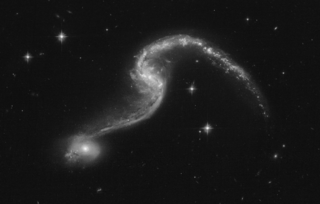
NGC 646 is a large barred spiral galaxy located in the constellation Hydrus. Its speed relative to the cosmic microwave background is 8,145 ± 19 km/s, which corresponds to a Hubble distance of 120.1 ± 8.4 Mpc. NGC 646 was discovered by British astronomer John Herschel in 1834. It forms an interacting galaxy pair.

IRAS 14348-1447 known as PGC 52270, are a pair of spiral galaxies located 1 billion light-years away in the constellation of Libra. The galaxy IRAS 14348-1447NE, is in the early process of merging with IRAS 14348-1447SW, causing gravity to pull stars from both galaxies and forming tidal tails. As the interaction takes place, molecular gas is swirled about and creating emission that is responsible for the galaxies' ultraluminous appearance.
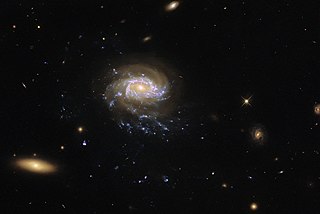
PGC 2456 known as KAZ 364 and JO201, is a spiral galaxy located in the constellation of Cetus. A member of Abell 85 galaxy cluster, it is located 617 million light-years away from the solar system and is considered a jellyfish galaxy due to the fact the tendrils are seen drifting downwards from its core. This mainly occurs when such galaxies like PGC 2456, moves through high speeds across the galaxy clusters, causing ram pressure to stripped gas, thus forming tendrils full of star formation. It is listed as a Seyfert galaxy by SIMBAD, meaning it has an active galactic nucleus. PGC 2456 lies 360 kiloparsecs from the brightest cluster galaxy, Holmberg 15A.
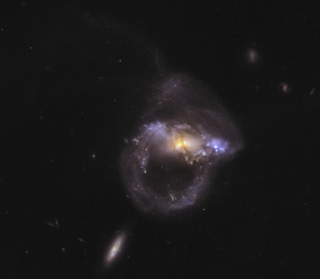
UGC 2812 known as Arp 219, are pair of interacting galaxies located 470 million light-years away in the Eridanus constellation. Both galaxies appeared to be distorted and tangled with each other which suggests their inevitable merging to form an elliptical galaxy. Moreover, they present a near-infrared spectra which could result from starbursts. Both objects are part of Atlas of Peculiar galaxies, where they are categorized under galaxies that have adjacent loops which are a manifestation of structures that were formed by gravitational interactions.
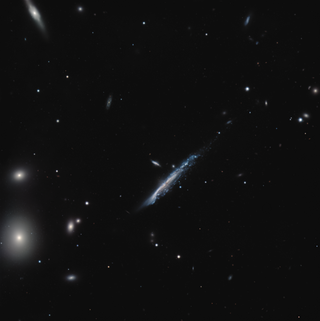
UGC 6697 is a large irregular spiral galaxy with a bar located in the Leo constellation. It is located 378 million light-years from the solar system and has an estimated diameter of 205,000 light-years. UGC 6697 is considered a starburst galaxy which produces high rates of star formation.

2MASX J09133888-1019196 are a pair of interacting galaxies located in the constellation of Hydra. It is located 735 million light-years from the Solar System.
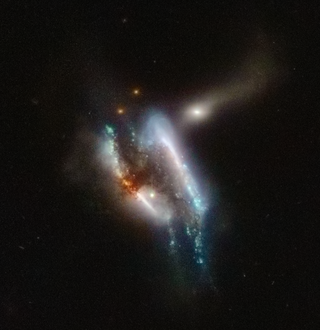
IC 2431 are a group of interacting galaxies in the constellation of Cancer. They are located 684 million light-years away from the solar system and were discovered on February 24, 1896, by Stephane Javelle.

SDSSCGB 10189 is a trio of interacting galaxies that is located in the constellation of Boötes. They are located 1.04 billion light-years away from the Solar System and are gravitationally interacting.

IC 1182 is a type S0-a lenticular galaxy located in Hercules. It is located 464 million light-years away from the Solar System and was discovered on August 11, 1892, by Stephane Javelle. IC 1198 is a member of the Hercules Cluster, which is a part of the CfA 2 Great Wall.

IC 1189 is a S0-a lenticular galaxy with a ring structure located in Hercules. It is located 557 million light-years away from the Solar System and has an approximate diameter of 145,000 light-years. IC 1189 was discovered on June 7, 1888, by Lewis Swift. It is a member of the Hercules Cluster.




















